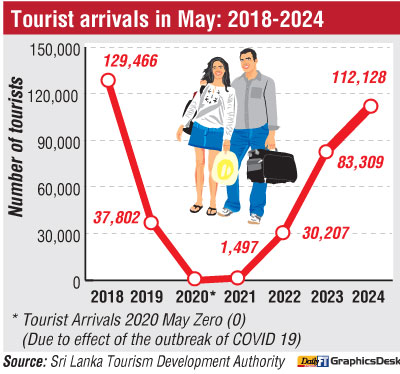Friday Apr 18, 2025
Friday Apr 18, 2025
Monday, 10 June 2024 02:01 - - {{hitsCtrl.values.hits}}
 Sri Lanka’s tourism industry continues to chalk up a striking performance, raking in over $ 1.4 billion in revenue during the first five months of 2024, marking a staggering 87% surge compared to the same period last year.
Sri Lanka’s tourism industry continues to chalk up a striking performance, raking in over $ 1.4 billion in revenue during the first five months of 2024, marking a staggering 87% surge compared to the same period last year.
The boost in revenue generation during the first five months is particularly significant, as it took the country almost nine months to reach a similar milestone the previous year.
The robust performance not only attributes to a strong recovery, but also highlights the industry’s potential for growth and resilience in the face of adversity.
Tourism earnings in May amounted to $ 154 million, reflecting 54% increase year-on-year (YoY)
indicative of the industry’s seasonal fluctuations. The month of May saw a total of 112,128 tourist arrivals, which registered a 35% YoY increase. However, on a month-on-month basis, May earnings saw a 32% decline. Despite this, 2024 May earnings remain the highest recorded post-COVID.
Since the Easter Sunday attacks in 2019, Sri Lanka’s tourism industry has faced numerous challenges and emerged stronger. This resilience has instilled renewed confidence in the sector’s ability to bounce back and thrive.
Ongoing promotional efforts and a renewed focus on safety and visitor satisfaction position Sri Lanka to reclaim its status as a top global tourist destination.
Sri Lanka crossing the 900,000 arrivals milestone so far in 2024, underscores the optimistic outlook, representing a significant increase from the previous year.
Looking ahead, Sri Lanka Tourism aims to attract 2.3 million visitors and generate over $ 4 billion in income for 2024. As tourism remains a crucial source of foreign exchange earnings for the country, efforts are underway to attract high-end tourists, with plans to increase the average spending per visitor to $ 4,000.
The Sri Lanka Tourism Development Authority (SLTDA) is targeting 2.5 million visitors to spend over $ 500 per day, with a focus on attracting high-spending travellers, who currently constitute a significant portion of tourists visiting the country.